A little revelation.
An acquaintance of mine once told me that he’d peg me as frugal and I told him that regarding certain things that’s true but with regard to others it’s not. Last night and today are reasonable examples of those opposing positions. Last night, I was among those in our group who attended the concert at the Musikverein. I happily let Ross purchase the tickets without giving a second thought to their cost. I don’t know if he bought the most expensive tickets available but if he did, that was fine with me. I wanted the experience. Likewise my decision to henceforth fly business class.
Today, our morning starts with a tour of the Kunsthistorisches Museum (Museum of Fine Arts) and also includes a tour of the Musikverein.
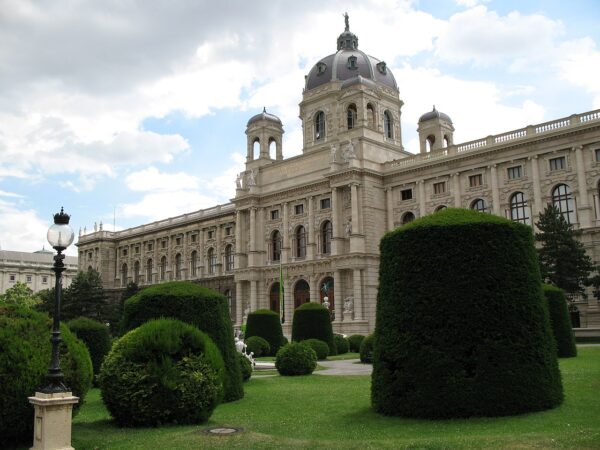
[Kunsthistorisches Museum from Wikimedia Commons – Andrew Bossi Own work CC BY SA 2.5[.
Those among you who have read about my past trips might have a vague recollection that in Madrid I passed on the opportunity to visit to the Prado and made a similar choice in Paris respecting the Louvre.
I’ve spent most of my adult life within a stone’s throw of of the Smithsonian Institution and the National Gallery of Art in Washington so while these famous international museums might hold a specific work or two that absolutely merits a visit, I don’t need to see their collections in general because I can view comparable works whenever the mood strikes. And I don’t have to fight crowds. However, I’d paid for this tour when I purchased the trip so, “Frugal-Todd” thinks, “Don’t toss that money away.” I approach group meals similarly. With that, come along with me first to
The Kunsthistorisches Museum.
Unlike some comparable art and art history museums in Europe such as the Louvre in Paris or the Hermitage in Saint Petersburg, the Kunsthistoriches Museum and the Naturhistoriches Museum (Museum of Natural History), its counterpart across Maria-Therezien-Platz, were designed and built to be museums. The idea of constructing grand new buildings to display the imperial collections arose in 1857 when Emperor Franz Joseph the First ordered the demolition of the old city wall to be replaced by a wide boulevard – the Ringstraße.
The architectural competition began a decade later but when the panel failed to nominate a winning design, Franz Joseph simply engaged Gottfried Semper known internationally for his museum designs. Semper’s grandiose plans that included a symmetrical pair of buildings featuring semi-circular façades aligned with the two museums weren’t fully realized. Only the two museums and the part of the Neue Burg (new palace) facing the Burggarten (palace garden) would be built. Work on the scaled down project began in 1871 and required 20 years to complete.
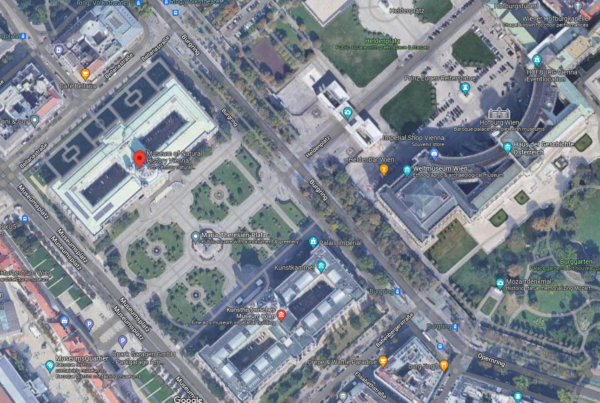
[Satellite screen capture from Google Maps.]
The museum’s website offers this description by the Neue Freie Presse of the grand opening:.
Today’s celebrations, which took place at the Kunsthistorisches Museum inaugurated by the Emperor, were joined by outstanding personalities of Vienna’s officials, artists and scientists. It was far more than a mere ceremonial act – it was a joyous party which celebrated Vienna’s modern, novel art within the palaces built and decorated for the purpose of exhibiting works of old art…
Visitors in the thousands flocked to the museum on a daily basis once it opened to the public. As for our small group, after passing through the entrance hall, staircase and cupola hall designed to celebrate Franz Joseph and his predecessors, we ascended the main stairs looking at Antonio Canova’s “Theseus Slaying the Centaur”
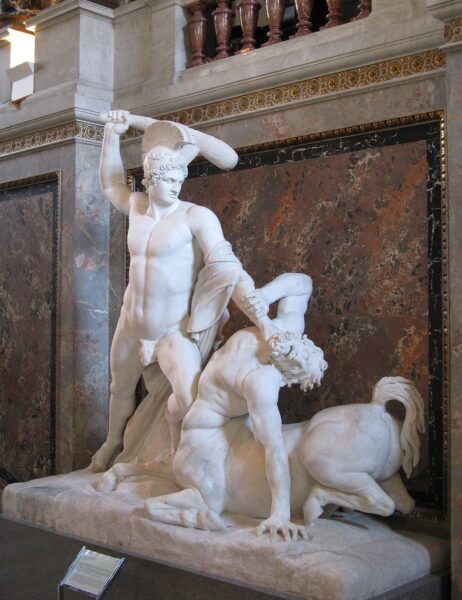
on our way.
Our guide Martha took us first through the Kunstkammer (art chamber) that I heard someone describe as a “one of its kind collection of curiosities and wonder.” (I took very few photos here and had none worth sharing so please feel free to watch the short video below.)
She led us through the section of the museum that featured Dutch, Flemish, and German painters giving us an overview of some of her favorites particularly those of Peter Bruegel the Elder such as his famous Winter Scene.

Martha left us there and the group agreed to take another hour or hour and a half to explore the museum before meeting at the museum café for lunch. I wandered through the gallery of Roman antiquities and into the Egyptian collection where I bumped into Bob (who, you might recall, I’d met with his wife Betty on my first Saturday morning at the hotel breakfast). He’d spent much of his allotted time there because he has a deep interest in Egyptology. Betty was elsewhere.
The café setting in the central rotunda was lovely

[Photo from www.khm.at]
but, as is often the case with museum cafés, a bit pricey. However, Earthbound was paying for the meal and so it was another two course choice. I had a red lentil salad and, for the second time since arriving in Vienna, a dessert of Kaiserschmarrn. (I’d had it at our first group dinner at Figlmüller. Shlomit had emailed us a video she’d narrated relating one of the three apocryphal stories of the history of the dessert’s name. It translates as “emperor’s mess.” In this telling, Franz Joseph’s wife Elizabeth, known as Sisi, was obsessed with maintaining a tiny waistline and insisted that any and all desserts be light. Once, when the chef presented her with this pancake like confection, she thought it too rich and refused to eat it. The emperor took it saying, “Let’s see what schmarren our chef has cooked up.” He finished both his and Sisi’s portions and it became a mainstay dessert of the court.)
Another look at the Musikverein.
Through the last third of the 19th century Franz Joseph I was affecting significant changes to both the look and cultural life of Vienna. He ordered the removal of the city walls in 1857 opening the way for the construction of the Ringstraße and the planning of the two museums. In 1863, he gave a plot of land opposite Karlskirche for the Gesellschaft der Musikfreunde (Society of Music Lovers) to construct a new concert hall. This would be the Musikverein.
Danish architect Theophil Hansen, who went on to design the Austrian Parliament Building, won the design competition principally by choosing not to compete with the nearby Staatsoper but instead to follow the Historicist style of buildings that would line the Ringstraße. (In the Historicist style, buildings are modeled on idealized versions of historical architectural styles but adapted to the technological and functional demands of the time in which they were built.)
From the building’s color schemes to the ionic columns and the temple roof in the Kleine Musikvereinssaal (Small Music Hall – known as Brahms Saal since 1937), to the caryatids and Apollo and the muses as the central feature on the ceiling in the Große Musikvereinssaal (Large Music Hall), Hansen intended to evoke Greek classicism.
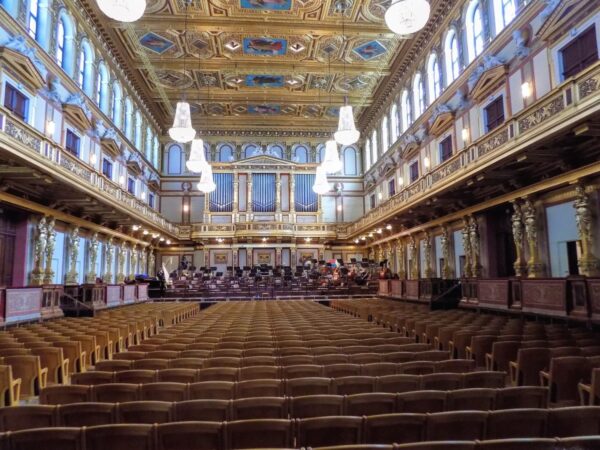
The new building was unique in Vienna when it opened with two concert halls in 1870. The Große Musikvereinssaal had a capacity of 2,000 concertgoers while the Kleine Musikvereinssaal accommodated 600. In 2004, the Musikverein added four new subterranean halls each with a clearly defined material theme – glass, metal, stone, and wood. The dimensions of the Glass Hall precisely correspond to the dimensions of the stage in the Große Musikvereinssaal.
The young woman who took us through the building had sung in the chorus we’d seen in the Large hall the previous night. All the singers in that large chorus she told us are volunteers.
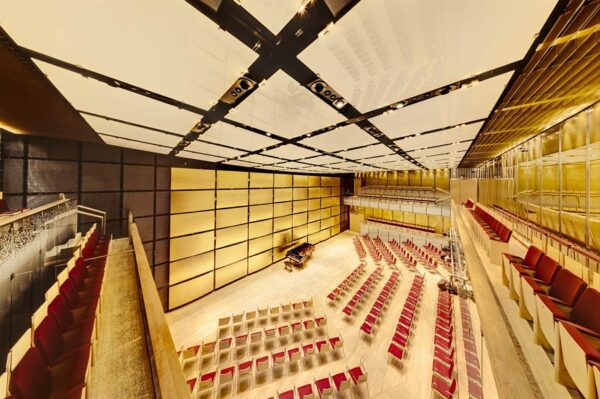
[Large rehearsal hall from www.musikverein.at].
I have a feeling full of desire
The day was growing late when we finished the tour so I went for a brief walk and grabbed a bite to eat at the StadtCafe that curiously proved to be the opposite of its description on Spottedbylocals. The writer described the food as “decent but secondary to people watching” and I found my crispy chicken salad delicious and the people watching quite secondary.
After dinner we were off to see, what the pre-tour program described as, “Vienna Volks Opera: Mozart’s beloved, The Marriage of Figaro.” It is, indeed a beloved opera. This production not so much. Sung in German with German surtitles, very sparse sets that required considerable imagination, two sopranos who were better than adequate but not spectacular, and a bass (Figaro) and baritone (Count Almaviva) who were too often swallowed up by the orchestra, it felt a bit like a low rent production. My grade would be in the range of C+ or B-.
It was late when we finally returned to the hotel but I didn’t sleep particularly well. My vet had sent an update on Zicomo indicating that he wasn’t responding to the antibiotic she was administering and she wanted to perform a very expensive lab test to pin down a more effective one. I instructed her to complete this course and try another and wrote that we’d discuss expensive tests when I returned. The decision was difficult and I slept fitfully.
Based on the tone of the story, I’m not sure what you are applauding other than the Kaiserschmarrn you had for lunch. It certainly wasn’t the “Vienna Volks Opera: Mozart’s beloved, The Marriage of Figaro“
It wasn’t. ? The answer is coming when I post all the music answers in the final post of this series.